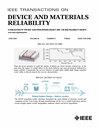动态拉伸应力下柔性a-InGaZnO薄膜晶体管的频率依赖性退化和失效
IF 2.5
3区 工程技术
Q2 ENGINEERING, ELECTRICAL & ELECTRONIC
IEEE Transactions on Device and Materials Reliability
Pub Date : 2023-08-09
DOI:10.1109/TDMR.2023.3303483
引用次数: 0
摘要
柔性电子器件在动态机械应力作用下的退化和失效往往限制了其运行,其中加载频率(${f}$)是本研究的一个关键因素。在0.7 ~ 2.7 Hz的动态拉伸应力范围内,研究了${f}$对柔性非晶铟镓锌氧化物(a- igzo)薄膜晶体管(TFTs)器件退化和失效的影响。TFTs表现出强烈的${f}$依赖性退化和失效行为,在GI/通道界面由机械应力诱导的纳米裂纹引起的失态电流下劣化较大,以及在较高的${f}\text{s}$时更频繁的金属丝裂纹。这种对柔性tft在微/纳米尺度上的强依赖关系使其与以往所有的观察结果相区别,这些观察结果表明,在机械应力下,传统的大块材料或厚膜材料的疲劳寿命与之相反或没有依赖关系。本文章由计算机程序翻译,如有差异,请以英文原文为准。
Frequency Dependent Degradation and Failure of Flexible a-InGaZnO Thin-Film Transistors Under Dynamic Stretch Stress
Operation of flexible electronic devices is often limited by their degradation and failure under dynamic mechanical stress, where the loading frequency (
${f}$
) is found to be a critical factor in this study. The effect of
${f}$
on device degradation and failure of flexible amorphous indium–gallium–zinc–oxide (a-IGZO) thin-film transistors (TFTs) under dynamic stretch stress is investigated in a
${f}$
range of 0.7 to 2.7 Hz. The TFTs exhibit strong
${f}$
-dependent degradation and failure behaviors, featuring larger degradation in off-state current due to mechanical-stress-induced nanocracks originated from the GI/channel interface, as well as more frequent metal wire crack at higher
${f}\text{s}$
. Such a strong
${f}$
-dependency on flexible TFTs in micro-/nano- scales distinguishes it from all previous observations of the opposite or nil
${f}$
-dependency of the fatigue life of conventional bulk or thick-film materials under mechanical stress.
求助全文
通过发布文献求助,成功后即可免费获取论文全文。
去求助
来源期刊

IEEE Transactions on Device and Materials Reliability
工程技术-工程:电子与电气
CiteScore
4.80
自引率
5.00%
发文量
71
审稿时长
6-12 weeks
期刊介绍:
The scope of the publication includes, but is not limited to Reliability of: Devices, Materials, Processes, Interfaces, Integrated Microsystems (including MEMS & Sensors), Transistors, Technology (CMOS, BiCMOS, etc.), Integrated Circuits (IC, SSI, MSI, LSI, ULSI, ELSI, etc.), Thin Film Transistor Applications. The measurement and understanding of the reliability of such entities at each phase, from the concept stage through research and development and into manufacturing scale-up, provides the overall database on the reliability of the devices, materials, processes, package and other necessities for the successful introduction of a product to market. This reliability database is the foundation for a quality product, which meets customer expectation. A product so developed has high reliability. High quality will be achieved because product weaknesses will have been found (root cause analysis) and designed out of the final product. This process of ever increasing reliability and quality will result in a superior product. In the end, reliability and quality are not one thing; but in a sense everything, which can be or has to be done to guarantee that the product successfully performs in the field under customer conditions. Our goal is to capture these advances. An additional objective is to focus cross fertilized communication in the state of the art of reliability of electronic materials and devices and provide fundamental understanding of basic phenomena that affect reliability. In addition, the publication is a forum for interdisciplinary studies on reliability. An overall goal is to provide leading edge/state of the art information, which is critically relevant to the creation of reliable products.
 求助内容:
求助内容: 应助结果提醒方式:
应助结果提醒方式:


